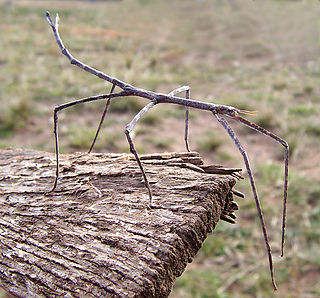
The Phasmatodea are an order of insects whose members are variously known as stick insects, stick-bugs, walkingsticks, stick animals, or bug sticks. They are also occasionally referred to as Devil's darning needles, although this name is shared by both dragonflies and crane flies. They can be generally referred to as phasmatodeans, phasmids, or ghost insects, with phasmids in the family Phylliidae called leaf insects, leaf-bugs, walking leaves, or bug leaves. The group's name is derived from the Ancient Greek φάσμα phasma, meaning an apparition or phantom, referring to their resemblance to vegetation while in fact being animals. Their natural camouflage makes them difficult for predators to detect; still, many species have one of several secondary lines of defense in the form of startle displays, spines or toxic secretions. Stick insects from the genera Phryganistria, Ctenomorpha, and Phobaeticus include the world's longest insects.

Phobaeticus serratipes is a species of stick insect that at one time was the longest known insect, with one female specimen recorded as being 55.5 cm (21.9 in) in total length. This measurement includes the legs fully extended front and rear, and the actual length of the body alone is considerably shorter. This insect is endemic to Peninsular Malaysia, Singapore and Sumatra. It is a popular species among those who raise insects.

The Euphasmatodea, also known by its junior synonym Verophasmatodea is a suborder of the Phasmatodea, which contains the vast majority of the extant species of stick and leaf insects, excluding the Timematodea. The oldest record of Euphasmatodea is Araripephasma from the Crato Formation of Brazil, dating to the Aptian stage of the Early Cretaceous.

The Phasmatidae are a family of the stick insects. They belong to the superfamily Anareolatae of suborder Verophasmatodea.

Eurycnema goliath, commonly known as the goliath stick insect, or the regal stick insect, is a large species of stick insect in the family Phasmatidae, endemic to Australia and considered one of the largest species of stick insects in the country. The species has the Phasmid Study Group number PSG14.

Ctenomorpha marginipennis, the margin-winged stick insect, is a species of stick insect endemic to southern Australia. The species was first described by George Robert Gray in 1833.
Asceles is a genus of stick insects in the tribe Necrosciini. Some of the species of Asceles have a distribution in Malaysia and Singapore.

Pulchriphyllium giganteum, commonly known as the Giant Malaysian Leaf insect, is a species of leaf insects described from Malaysia by Hausleithner in 1984 and placed in the genus Pulchriphyllium since 2021. Pulchriphyllium giganteum is the largest species belonging to the genus Pulchriphyllium reaching 105 mm in size. They are found most abundantly in the west Malaysian tropics. The females typically have large elytra that lie edge to edge on the abdomen and tend to lack hind wings making them usually flightless. Males have small elytra and sometimes transparent non-leaflike functional hind wings. Pulchriphyllium giganteum found in the wild tend to be mostly females and the first male of this species was not found until 1994. In captivity, the species has primarily been observed to reproduce through parthenogenesis meaning the females are asexual. The primary reproductive pattern in the wild is unknown. Eggs tend to be brown or black and glossy and resemble seeds. They hatch around 6 months after breeding. Newly hatched young nymphs tend to be wingless and brown or reddish in color. They develop their green color after feeding on leaves. Both the adult and larval stages are phytophagous meaning they feed on plants. The main plant food sources for this species are oak and bramble tree leaves.

Aschiphasmatidae are a family of stick insects belonging to the suborder Verophasmatodea; they can be found in Indomalaya.
Anisacanthidae is a family of walkingsticks in the order Phasmatodea. There are about 10 genera and at least 30 described species in Anisacanthidae.
Damasippoididae is a family of walkingsticks in the order Phasmatodea. There are at least two genera and about six described species in Damasippoididae, found in Madagascar.

Paramenexenus is a genus of Asian stick insects belonging to the family Lonchodidae, erected by Josef Redtenbacher in 1908.

Orestes japonicus, a stick insect, is a representative of the genus Orestes.

Orestes shirakii is a species of stick insects native to Taiwan.

Eurycnema versirubra, the red-winged green giant stick insect/Timor Giant Stick Insect, is a species of stick insect from Timor, Solor and Wetar, The original habitat of Eurycnema versirubra might be Timor and / or closeby islands. They were most likely brought from there to Java and Malaysia, where they are known from captive bred cultures only. In Timor, the Timorese greatly fear the species because they consider it to be highly poisonous. As a result, the insects are often killed by the Timorese. Contrary to common belief, the Timor Giant Stick Insect is not dangerous.

Phasma gigas is a large-sized stick insect found in Maluku Islands, Sulawesi, Gorong Islands and Kei Islands. It is often believed that Phasma gigas is present on New Guinea, but in fact, all New Guinean records actually refer to Phasma reinwardtii. Furthermore, the historic records from Sulawesi are doubtful and need more evaluation.

Phasma reinwardtii is a large stick insect found in West Papua and Papua New Guinea.

Nesiophasma giganteum is a recently described species of stick insect, order Phasmatodea. It is endemic to Peleng. Adult females are large, typically measuring 250–300mm in body length. Both sexes are wingless.
Pseudodiacantha is an Asian genus of stick insects in the family Lonchodidae and subfamily Necrosciinae. Members of Pseudodiacantha are excellent examples of camouflage, as they are known to cover themselves in mossy or lichenous outgrowths that supplement their disguise.
Neooxyartes is a monotypic genus of Asian stick insects in the tribe Necrosciini, erected by G.W.C. Ho in 2018. To date (2022) the sole species has been recorded from Vietnam.















